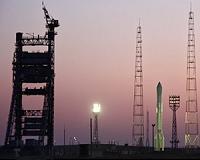 |
Washington (AFP) March 4, 2011 A NASA satellite that aimed to study the impact of aerosols on climate plunged into the Pacific Ocean on Friday, delivering a $424-million blow to the US space agency. The failure of the Glory satellite launch was the second bungle for NASA climate science efforts in two years, and closely resembled a botched carbon satellite launch involving the same company, Orbital Sciences Corp., in 2009. Glory could not reach orbit after its protective clamshell-like nose cone cover failed to detach after launch, engineers said as they struggled to figure out why the expensive technology collapse had happened yet again. "We are all pretty devastated," said Ron Grabe, executive vice president and general manager of the Virginia-based Orbital's Launch Systems Group, which made both the rocket and satellite. Grabe appeared at a press conference Friday along with other grim-faced executives and NASA experts as the US space agency announced the creation of a "Mishap Investigation Board to evaluate the cause of the failure." "We encountered no anomalies" early on, NASA launch director Omar Baez told reporters. But a few minutes into the flight, it became apparent that separation of the cover, known as a fairing, had not occurred. "We didn't see the indication of fairing separation," said Baez. "We failed to make orbit and all indications are that the satellite and rocket are in the southern Pacific Ocean somewhere." The launch of the satellite -- which was to measure aerosols in the Earth's atmosphere to help clarify their impact on climate -- was delayed on February 23 after an unexpected ground control reading 15 minutes before liftoff. On Friday it blasted off from Vandenberg Air Force Base in California aboard a four stage Taurus-XL rocket at 2:09 am (1009 GMT), but NASA soon reported that it was slowing down and would not reach orbit. A similar mishap took place in February 2009, when a satellite designed to monitor global carbon dioxide emissions plummeted into the ocean near Antarctica after failing to reach orbit, in a setback for climate science. There too, a fatal mission error occurred minutes after liftoff when the fairing, which protects the satellite during its ascent, failed to separate properly. But experts said it was too early to know if the Glory failed for the exact same reason, and that more analysis was needed. "Right now we are crunching the data but there is not enough data that has been processed to tell any more than the fairing did not deploy," said Rick Straka, deputy general manager at Orbital. Grabe said engineers had done extensive research on the previous failure, and went so far as to completely change out the initiation system and replace it with another one that had flown successfully three times. "So we really went into this flight feeling confident that we had nailed the fairing issue," said Grabe. "There is a great deal of emotional investment on the part of all the players on any spaceflight but that is probably doubly so on a return-to-flight effort like this one," he said. "We will recover. The team will bounce back. They are all professionals and Orbital Sciences will bounce back with the Taurus vehicle," said Grabe. The satellite itself weighed 1,164 pounds (528 kilograms), and carried two main instruments, the Aerosol Polarimetry Sensor and the Total Irradiance Monitor which was to be directed at the Sun. Glory was supposed to chart an orbital course 340 nautical miles (630 kilometers) above the Earth, before employing an on-board propulsion system to raise its orbit to 438 nautical miles (811 kilometers). It was then supposed to join what is known as the "A-Train" of Earth-observing satellites sent up by NASA. The five already there -- Aqua, Cloudsat, Calipso, Parasol and Aura -- fly in formation, crossing the equator every afternoon.
Share This Article With Planet Earth
Related Links Launch Pad at Space-Travel.com
 Russia Lacks Enough Carrier Rockets To Fulfill 2011 Launch Plans
Russia Lacks Enough Carrier Rockets To Fulfill 2011 Launch PlansMoscow, Russia (RIA Novosti) Mar 03, 2011 Russia lacks carrier rockets to carry out all space launches scheduled for 2011, the head of the Roscosmos space agency said on Wednesday. "We have a number of spacecraft that should be launched this year, but we do not have [enough carrier] rockets," Roscosmos chief Anatoly Perminov said in an interview with the Voice of Russia radio station. He also noted that there were more launc ... read more |
|
| The content herein, unless otherwise known to be public domain, are Copyright 1995-2010 - SpaceDaily. AFP and UPI Wire Stories are copyright Agence France-Presse and United Press International. ESA Portal Reports are copyright European Space Agency. All NASA sourced material is public domain. Additional copyrights may apply in whole or part to other bona fide parties. Advertising does not imply endorsement,agreement or approval of any opinions, statements or information provided by SpaceDaily on any Web page published or hosted by SpaceDaily. Privacy Statement |